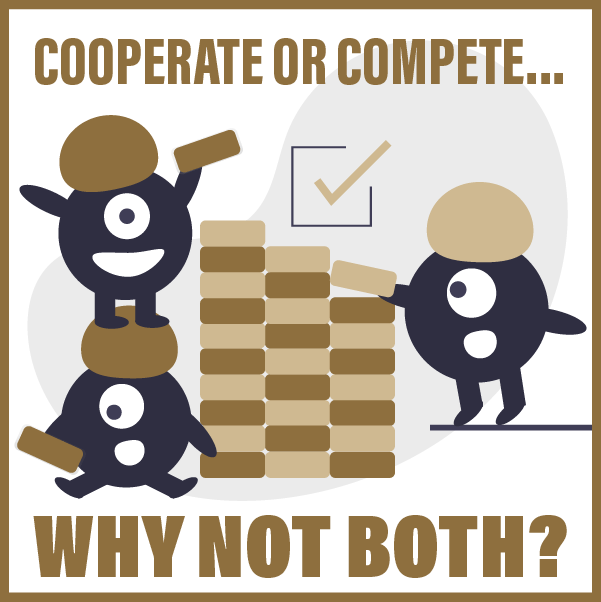Cooperate or Compete? Why Not Both?
Rev iewer
iewer
Dr. Allan W. Gray, Executive Director and Professor
Article
Coopetitive Innovation Alliance Performance: Alliance Competence, Alliance’s Market Orientation, and Relational Governance by Bicen P., S. D. Hunt, and S. Madhavaram
Journal
Journal of Business Research, 123 (2021), 23-31
Summary
In this article, the authors conduct an extensive review of the literature, engage a panel of industry experts and implement an applied research study to define and measure the elements that make innovation alliances among competitors successful. The focus of the study was around alliances that were built on relationships rather than formal contractual relationships.
The research discovered one of the more critical elements that leads to a successful alliance is the alliance’s market orientation. That is, the alliance has a higher probability of success if there is a clear focus on creating a unique customer value proposition focused on how the two firms can coordinate to respond to the actions of competitors in ways that create real value for customers. The research also found that when focused and practiced, these customer, competitor and coordination elements lead to increased levels of trust and commitment (known as relational governance) among alliance members. Finally, the research showed that when markets and the competitive environment are more turbulent, the market orientation factors of the alliance become even more important in leading to alliance success.
What this means for Food and Agricultural Business
It seems turbulence, disruption and innovation are all terms we use daily in today’s agribusiness environment, and navigating these times is challenging to say the least. Many of us are looking for solutions to challenges centered around market volatility, consumer expectations, regulations, technology advancements and more. Yet, we also have to run our businesses today. This often leads to the consideration of creating alliances to “join forces” and help identify opportunities. Of course, strategic alliances in our industry are not new; however, today’s environment may have more of us considering them.
This research paper looks specifically at strategic alliances between competitors — something many of us may be reticent to consider during normal times. But these times are anything but normal. Perhaps there are opportunities to navigate the changing landscape of food and agriculture by considering a coopetitive alliance like the one evaluated in this research paper. In fact, the authors found that these types of alliances are quite common in the industries of: biotechnology, semiconductors, medical devices, hardware, electronics and chemicals. The argument is that the high pace of innovation, competition and growth in these industries lead to coopetitive alliances — all characteristics that sound similar to today’s food and agriculture industry.
If we are to consider these coopetitive alliances, the research points out that the most critical success factors are centered around clarifying the market orientation of the alliance. The article provides compelling evidence that competitors can be successful in an alliance if the focus is on creating a new and unique value proposition for customers. That is, the alliance should be oriented towards the market rather than focused on basic research or operational efficiencies. Before reading this article, I would not have thought this to be the case. I would have believed that operational efficiencies would be the primary driver of an alliance, perhaps because this is what I have witnessed in the past; but I would say that most were only modestly successful at best.
The article challenges us to think about how competitors can work together to create new customer value, build trust and commitment in the alliance and yet still compete with each other. The authors highlight that firms that create coopetitive alliances with a clear focus on creating new value propositions often do so in response to a competitive threat, either from another competitor in the industry or an emerging competitor from another industry. When the catalyst to have this market orientation is there, it creates a “shared destiny” mentality that actually reinforces the building of trust and commitment, thereby strengthening the relational contract between the alliance partners and leading to stronger outcomes from the alliance.
One example we might consider as a coopetitive alliance in the ag input supply industry is the formation of CommoditAg. Essentially, CommoditAg is an alliance of several regional cooperative retail organizations that, at times, compete with each other but, in this case, they chose to collaborate in response to the growing pressure from e-commerce in the agricultural retail space. Some may quibble about CommoditAg being a true coopetitive alliance, but it seems to me it has many of the elements. The research article would suggest that CommoditAg is most likely to be successful if it can stay focused on creating a unique value proposition for farmer customers, respond effectively to the changing competitive environment of e-commerce and effectively coordinate the resources of its parent members to deliver on the unique value proposition.
We spend most days trying to deliver our current value proposition and beat out our competitors, yet today’s volatile marketplace might suggest there are opportunities to collaborate with our competition. As we consider this approach to deal with some of our bigger challenges, are we keeping a focus on opportunities that create unique value in the marketplace, or are we only comfortable sticking to traditional collaborations focused on operational efficiencies?
RELATED POSTS:
A great moment for value-based sales in agribusiness
Value-based sales can empower companies to craft compelling value propositions, understand the customer’s business model and effectively communicate to stakeholders.
How can big data empower the development of new products?
Data is one of the most powerful resources for a company. It enables accurate decision-making and minimizes risk, ensuring greater revenue and sustainable growth.
Unlocking Growth: Exploring innovation dynamics in the agrifood sector
The future for the agrifood sector appears promising, driven by technological advances, strategic M&A activity and a growing commitment to innovation.
